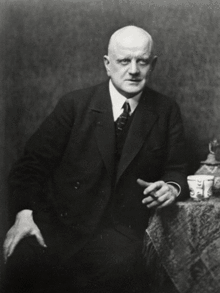Symphony No. 6 (Sibelius)
| Symphony No. 6 | |
|---|---|
| by Jean Sibelius | |

Sibelius in 1923
|
|
| Key | D minor (Dorian mode) |
| Catalogue | Op. 104 |
| Composed | 1923 |
The Symphony No. 6 in D minor, Op. 104, by Jean Sibelius is a symphony completed in 1923. Although the score does not contain a key attribution, the symphony is usually described as being in D minor; much of the symphony is in fact in the (modern) Dorian mode (Pike 1974, 318–19). A typical performance lasts about 25 minutes. The composer called the work "cold spring water" in opposition to many contemporary "cocktails"—a veiled reference to Igor Stravinsky's often elaborate and extravagant orchestral style.
It was premiered by the Helsinki Philharmonic Orchestra, conducted by the composer, on 19 February 1923. It was to be dedicated to the Swedish composer Wilhelm Stenhammar, but the publisher lost the dedication page.
The work is scored for 2 flutes, 2 oboes, 2 clarinets, bass clarinet, 2 bassoons, 4 horns, 3 trumpets, 3 trombones, harp, timpani and strings.
The symphony has four movements:
The Sixth has been called "the Cinderella of the seven symphonies" by musicologist Gerald Abraham (Abraham (1947,) Sibelius wrote in 1943 that "the sixth symphony always reminds me of the scent of the first snow". In a remark published in 1955 he said "Rage and passion ... are utterly essential in it, but it is supported by undercurrents deep under the surface of the music". Scholars have detected the influence of Palestrina, whose music was studied by Sibelius.
...
Wikipedia
